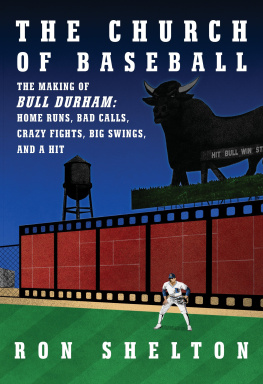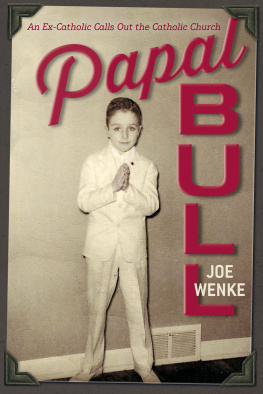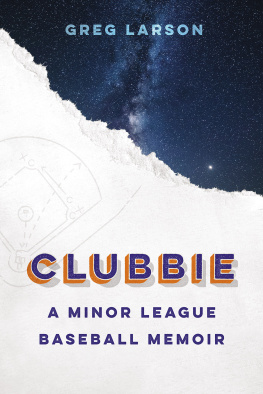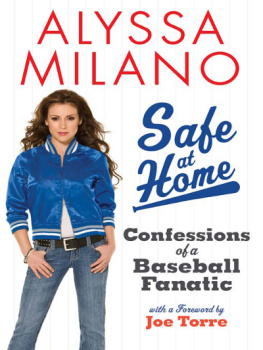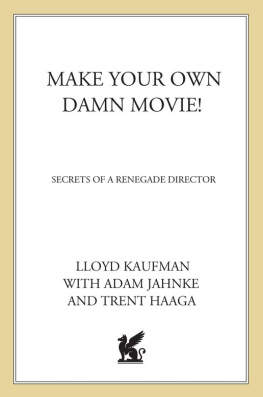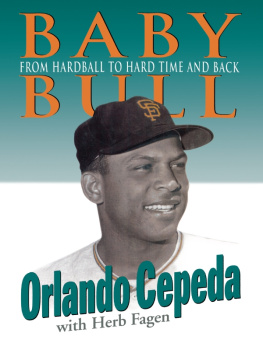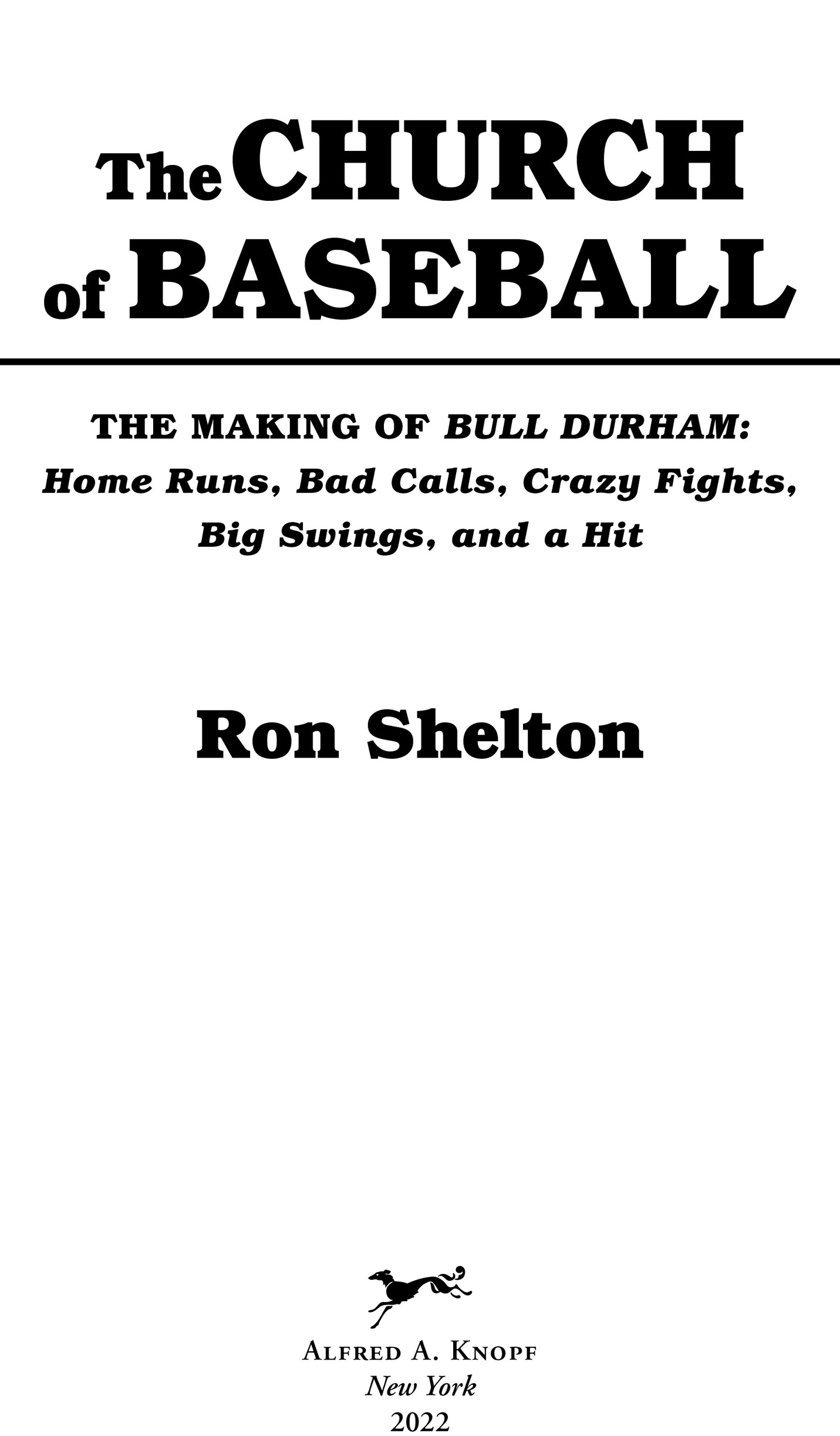Contents
Landmarks
Print Page List
THIS IS A BORZOI BOOK PUBLISHED BY ALFRED A. KNOPF
Copyright 2022 by Ron Shelton
All rights reserved. Published in the United States by Alfred A. Knopf, a division of Penguin Random House LLC, New York, and distributed in Canada by Penguin Random House Canada Limited, Toronto.
www.aaknopf.com
Knopf, Borzoi Books, and the colophon are registered trademarks of Penguin Random House LLC.
Library of Congress Cataloging-in-Publication Data
Names: Shelton, Ron, 1945 author.
Title: The church of baseball : the making of Bull Durham : home runs, bad calls, crazy fights, big swings, and a hit / Ron Shelton.
Description: First edition. | New York : Alfred A. Knopf, 2022. |
Identifiers: LCCN 2021049945 | ISBN 9780593319772 (hardcover) | ISBN 9780593313961 (trade paperback) | ISBN 9780593319789 (ebook)
Subjects: LCSH: Shelton, Ron, 1945 | Bull Durham (Motion picture) | Motion picturesProduction and directionUnited StatesHistory20th century. | Baseball filmsUnited StatesHistory and criticism. | Baseball in motion pictures. | Motion picture producers and directorsUnited StatesBiography. | ScreenwritersUnited StatesBiography.
Classification: LCC PN1997.B7926 S54 2022 | DDC 791.43/72dc23/eng/20211110
LC record available at https://lccn.loc.gov/2021049945
Ebook ISBN9780593319789
Cover design and illustration by Dave Plunkert
ep_prh_6.0_140819454_c0_r2
For Rath and Peg
Contents
Introduction
Not long ago, I was in Durham, North Carolina, to honor the thirtieth anniversary of the movie Bull Durham. As the writer and director of the film, I was to be trotted around the new ballpark that is now the home of the AAA Durham Bulls. Every night, I had a cocktail at the beautiful hotel barthe Bull Durham Bar, in fact, named for the movie.
I was amazed to find that many locals credited the turnaround of the city to the opening of the movie in 1988. Its true that when I scouted Durhameven before I wrote the film scriptit was boarded up and in trouble. Its longtime economic engine, Big Tobacco, had ended, and there seemed to be nothing to replace it. The desperate look and feel of this southern town, with its ancient, crumbling ballpark and shuttered businesses, suggested the perfect background in which to set a story in the minor leagues where young athletes dreams similarly crumble and are boarded up. The entire region was ultimately reinvented when the tech boom of the nineties turned the Research Triangle Park (defined by the vertices of Raleigh, Durham, and Chapel Hilleach with a major university) into a kind of Silicon Valley of the South. Nonetheless, the movie seemed to get much of the credit, whether it deserved it or not.
Being on site reminded me of when I got on the plane to go back to Durham right before filming began, having nothing but doubts. Susan Sarandon was not a bankable commodity professionally at that moment, Tim Robbins was an unknown, and Kevin Costner had just burst onto the scene. The three of them had barely met, and while it seemed there was the possibility of chemistry among them, I had no proof; it was mostly an instinct.
It wasnt until rehearsals started in Durham that I began to feel that this could be a special group. Tim brought dignity to Nuke, Kevin kept the child alive in the fading Crash Davis, and Susan grounded Annie Savoy with a nonjudgmental generosity that transcended the characters eccentricities. As actors, they liked and respected one another, and that ultimately translated into the affection they had onscreen.
But then, after shooting began, the deflating pushback started from the studio, and suddenly I was fighting with the suits to defend what seemed to not need defending, namely the performances. I was fighting for what turned out to be one of the movies strengths, and those fights drained my energy and took time away from focusing on the filmmaking itself. Id learn in later movies that this is part of the drillfighting the fights that shouldnt need fighting.
John Huston once said that directing a movie is like going to war. This may be an exaggeration, but its sure as hell a contact sport. Why that is soand why its always been sois a mystery to those in the trenches. Why do those writing the checks and the producers midwifing the project always throw obstacles in the way of the creative process? I suppose its not that complicatedthe engine that drives Hollywood is the ego. The financier is determined to prove he is not just about money but has a creative bent as well. Sometimes its just politics as usual, or the stars girlfriend once dated the financier and it ended badly, or your agent hates my lawyerthe usual stew of cheap soap opera, except in the stew, money and careers and possibly good movies are at stake. Art patrons have always wanted to be heardPope Julius II surely told Michelangelo he thought Adams thighs were a little meaty, and its well recorded that Robert Evans drove Francis Ford Coppola mad as he tried to make The Godfather. The sublime irony is that sometimes the pope and Robert Evans are right, though mostly theyre not. The Sistine Chapel and the Paramount movie came out pretty well. The director has to listen and accept and fight backits a curious behavioral contortion to have all your nerve endings open for discovery while you circle the wagons to defend your vision. Sometimes it helps to have an enemy; if none exists, its sometimes the directors job to invent one. Bogeymen, real or imagined, are handy to rally the troops against. Long ago these enemies were dubbed the suits and have taken on mythic status as the antagonistic other. There are legendary directors who invent the other as part of their daily bread; the oxygen they breathe is the war they imagine theyre involved in.
Some famous director said that directing is fifty percent the cast and fifty percent the script, and while thats too reductive, its also loaded with the truth. Even John Huston similarly confessed: I remove myself from the rigors of directing by casting the movie properly. You cant overcome a casting mistake no matter how clever the editing or, as the joke goes, how high you crank the music, but I got lucky on Bull Durhama perfect cast. Screen chemistry is a mysterious thing, undefinable and unable to be conjured by the most brilliant director or reinvented in the editing room. And while it cant be explained by film science, the simple truth underlying all great onscreen chemistry is this: two characters must occupy different emotional and physical spaces. Nuke couldnt be a younger version of Crash; they had to be different physically, politically, emotionally, and come from different backgrounds, even if none of that is revealed. They had to have different comfort zones as actors. Kevin and Tim are completely different people and in real life one cant imagine them competing over the same thing. In a movie, however, its not hard to imagine them fighting over the same woman.
I say all this because, as happy as I am with the final movie, the making of Bull Durham was a troubled exerciseand of course we had our own othersbut in retrospect, several movies later, it was a pretty normal series of fights, lies, clashing egos, and bloodshed, all leading toward a funny, life-embracing movie, due in large part to the incredible cast.
Making a good and successful movie is a minor miracle every time.

